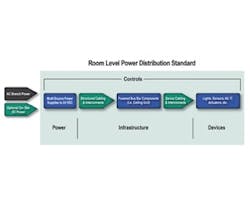An Innovative Power Platform
Today’s buildings are powered by traditional AC sources but populated with DC-powered devices like computers, phones, and IT equipment. Even lighting systems, which are typically AC-driven, are becoming more DC-powered as LEDs and advanced lighting controls become prevalent.
Requiring DC devices to adapt to AC building systems, however, doesn’t use power very efficiently because AC must be converted to DC at the device level. The EMerge Alliance has developed an open standard for hybrid interior power distribution systems that convert AC to DC power at the room level and distribute it to DC devices.
This upstream conversion also invites the efficient use of on-site alternative power generation or storage sources that naturally supply DC power, including solar arrays and wind micro-turbines. Matching renewable energy sources with interior energy loads like lighting, and avoiding the typical inversion to AC power, can make on-site sources 10 to 15 percent more efficient.
The EMerge Standard defines a multi-functional, low-voltage, DC microgrid power distribution infrastructure layer that interconnects sources of power to devices in the space that draw power. Further, it defines the control systems necessary to monitor and control such devices and power sources.
As shown on this page, an EMerge system functions physically in a way that’s similar to traditional spaces. The EMerge Standard encourages the use of interior finish infrastructure (suspended ceilings, furniture, floors, or walls) to be used for power distribution. The infrastructure incorporates electrically active bus bar components to distribute power to lighting fixtures, sensors, speakers, actuators, motors, or wireless devices. Power devices deliver 24V DC current through the infrastructure via low-voltage wiring power cable assemblies. Controls allow active components of the system to perform basic on/off, level, monitoring, and metering functions involving the power to or from those devices.
With the rapid developments in DC power line communication and wireless control protocols, it’s expected that the EMerge Standard will incorporate updates on a regular basis. The EMerge Alliance is also collaborating with groups focused on DC power in data centers. B
Ben Hartman is chairman of the EMerge Alliance’s Technical Standards Workgroup (www.emergealliance.org).
